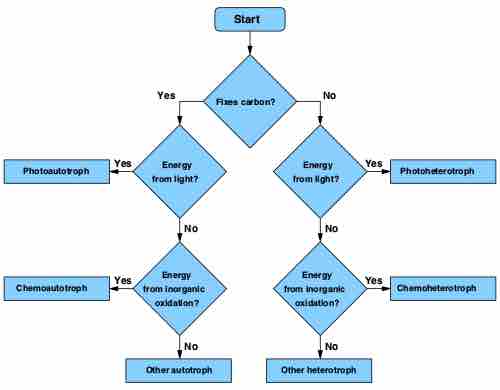Microbial Growth Cycle
All microbial metabolisms can be arranged according to three principles: 1) How the organism obtains carbon for synthesizing cell mass. 2) How the organism obtains reducing equivalents used either in energy conservation or in biosynthetic reactions. 3) How the organism obtains energy for living and growing (for more detail on this topic see atom on Growth Terminology). Unlike in multicellular organisms, increases in cell size (cell growth and reproduction by cell division) are tightly linked in unicellular organisms. Bacteria grow to a fixed size and then reproduce through binary fission which is a form of asexual reproduction. Under optimal conditions, bacteria can grow and divide extremely rapidly. These optimal conditions are discussed below.

Metabolic characteristics of microorganisms
This is a flowchart to help determine how a microorganism undergoes growth development.
Oxygen Requirements
Different kinds of bacteria need different amounts of oxygen to survive, which determines which bacteria can infect which parts of the body. They are not able infect the skin because oxygen is present, and they can only grow in the presence of oxygen. Conversely, obligate anaerobes are killed by oxygen and carry out fermentation. Tetanus is an obligate anaerobe so it will infect areas where oxygen in limited. Aerotolerant anaerobes breath anaerobically (without oxygen), but they are able to survive when oxygen is present.
Nutrient Requirements
For microbial growth to process, microorganisms require certain nutrients including carbon, nitrogen, phosphorus, sulfur, and metal ions.
Temperature Requirements
Various types of bacteria thrive at different temperatures. Microorganisms that grow best at moderate temperatures are called mesophiles. Those surviving at high temperatures are thermophiles and microorganisms surviving at very low temperatures are called psychrophiles.